Do you remember the Workshop topic called "Dr. Peter T Prototype" that Glenn Habrial moderated until either he or we lost interest? It was a great feature that required us to use our knowledge of real or prototype railroads. Well, this article is about a real railroad device that is worthy of being included in Glenn's workshop. For several years as a model railroader, I have always noted with interest a feature found on many model railroads in the smaller scales, but I don't believe that I have ever seen one of them on a Large Scale railroad. That feature is a piece of equipment called a "telltale". When I told Jon that I had modeled some for my railroad and I was going to do an article on it, he told me he didn't know what they were and would have to wait to read my article to find out about them.
Those of us, who are also sailors of real sailboats, know about one kind of telltales. You find them on the sails of sailboats. In this application, they are small strips of cloth fastened to the sails that when they line up parallel to the surface of the water tell us that our sails are properly trimmed. "Telltales" is also the newsletter of the Boulder, Colorado Model Railroad Club. Finally Telltales in steam locomotives are longitudinal holes drilled in the stays of the firebox to provide early warning of corrosion. But even though I am a sailor and I love model and real railroading, I didn't model a Large Scale sailboat with telltales on it, nor did I publish the newsletter or build a real steam locomotive. What I modeled was the structure you see in the following photo. It consists of a tall pole with a longitudinal arm with several ropes suspended over the center of the rail.
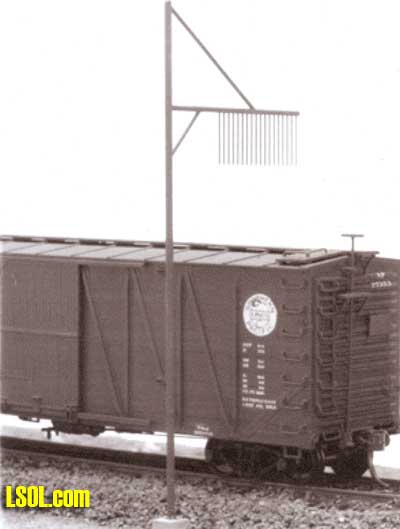
I did find two definitions for telltales on the Internet. The first from a railroad site says: "TELLTALES - Any device that serves as a warning. Specifically the row of strips hanging down a short distance in front of a tunnel or low bridge to inform trainmen who are riding car tops that they'd better duck." Wikipedia says: "A tell-tale is a series of ropes suspended over the tracks above the height of a boxcar. These ropes are intended to give warning to a brakeman on the roof of the train that the train is approaching a low-clearance obstacle, such as a tunnel or a bridge.
A Chesapeake and Ohio Railway tell-tale had 17 of these ropes hanging from a tube suspended across the track, the bottom of the ropes 12" lower than the height of the obstruction, and placed 100 to 300 feet before the obstruction." I found current railroad regulations from several states that mandate the minimum clearance heights for bridges and tunnels, but also state that if the height is less than 23 feet above the top of the rails then telltales are required to be installed. So there may be a few telltails still around on modern railroads protecting anyone riding on top of a railroad car.
I constructed my set of four telltales to provide warning for the two bridges that I recently completed on my railroad. These bridges were about 11 inches above the tops of the rails.
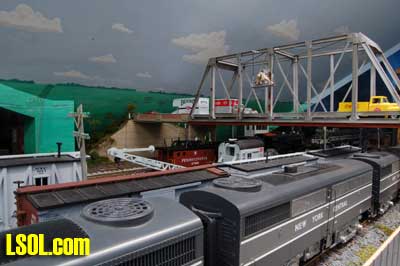
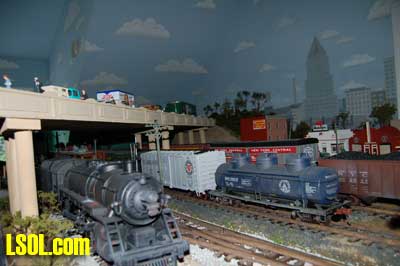
I began construction of my telltales by cutting 3/8-inch wooden dowels into four 15-inch lengths. I made two cuts in the poles at the height I wanted the horizontal suspension arm so that the 2-inch telltales would hang down at the height of the bottom of the bridges. I also cut the longitudinal arm from 1/4 X 1/4" wood. My razor saw was used to cut the wood and cut the edges of the notches. I used a small chisel to complete the notches and finished smoothing the notch with a hobby knife.
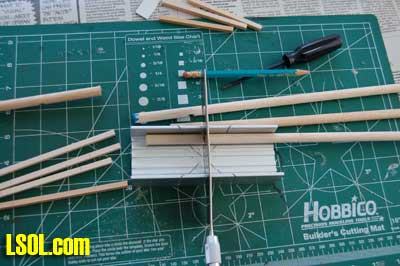
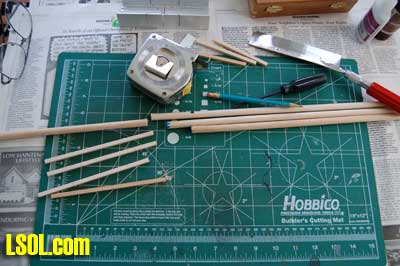
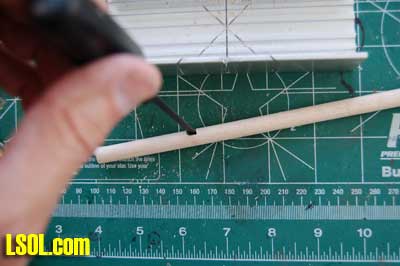
To represent the rope hanging down from the horizontal beam I considered using string and stiffening it with glue, but since I didn't have any string available at the house, I found some 20 gauge steel wire to use instead.
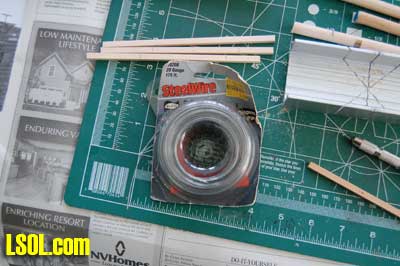
I cut the steel wire into 2-inch lengths using a pair of side cutter pliers. I made thirteen of them for each pole.
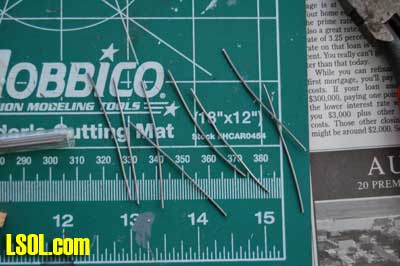
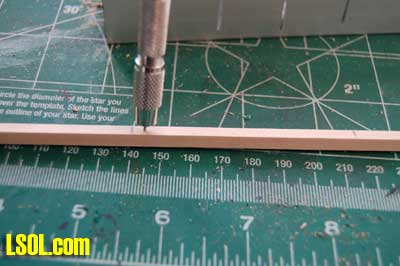
Using my pin vise and a small bit, I drilled thirteen holes in the horizontal beam eyeballing the distance between each hole.
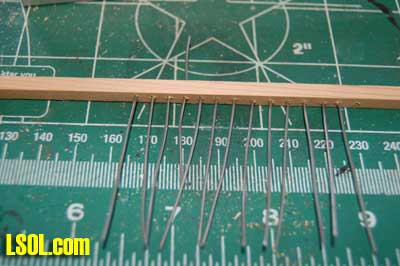
I inserted the 2-inch wires into the horizontal brace leaving the ends sticking up above the beam. I put a drop of acrylic caulk/adhesive on each wire and them pushed them down into the beam so that the ends were flush with the top of the beam.
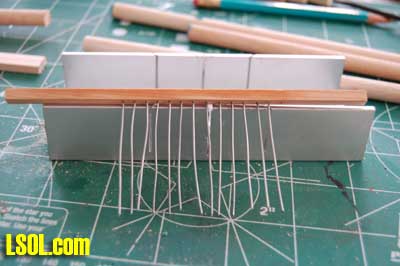
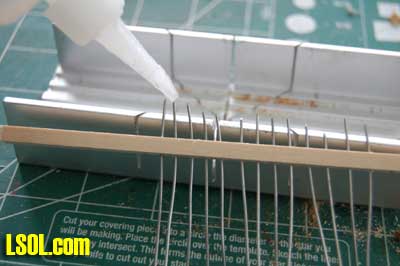
I fastened the horizontal beam to the pole by gluing it in the notches I had cut in the poles. Next I cut two braces from the 1/4 X 1/4" wood using the razor saw to make the angle cuts and glued them in place supporting the horizontal beam. Again I eyeballed the length and angles and simply cut them to fit.
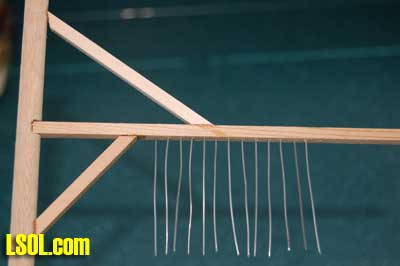
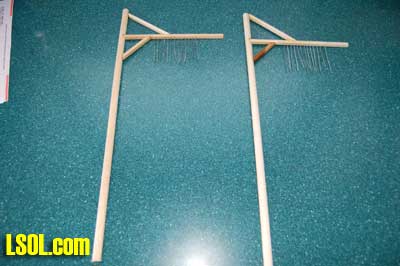
After the glue dried, I spray painted the metal wires with flat black paint and let the spray touch some of the wood parts to represent coal smoke soot. I stained the poles with a dark stain and after the stain dried, I lightly sprayed the poles with a flat grey paint to make the poles appear the correct color of aged wood.
After the paint was completely dry, I took the poles up to my railroad and used a power drill to drill holes next to the ballasted roadbed. I placed the poles an appropriate distance back from the bridges on each track and adjusted the height to the correct position.
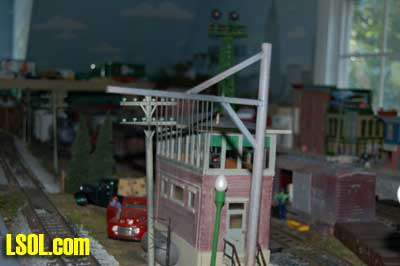
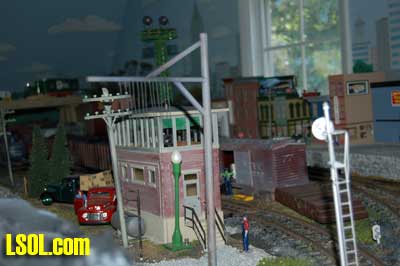
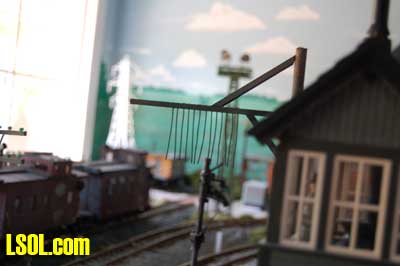
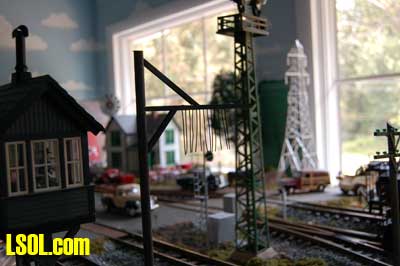
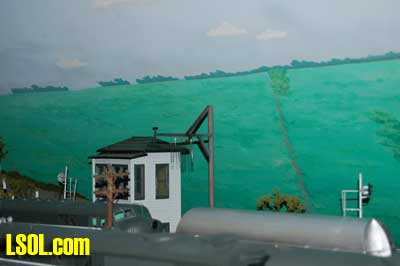
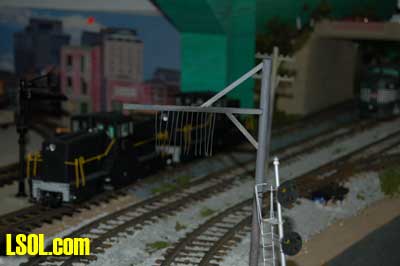
After all four poles were installed, I started up a freight train and moved a boxcar up to the telltale and placed on of my brakemen on top of the car. I made the final height adjustment with the brakeman looking at the telltale.
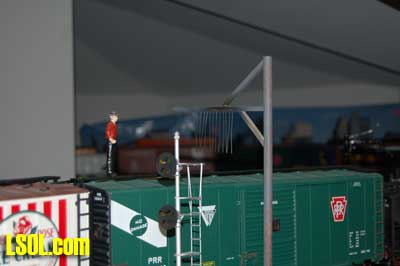

This project took about 3 hours to complete and the telltales add an authentic look to my railroad. They also add protection to the many brakemen on my railroad who sometimes find that they must be up on top of the cars while the train is in motion. Hopefully, the telltales will keep them from losing their heads when they become too distracted to know exactly where they are as they move along. If you want a simple project for a rainy day, try making some telltales to warn your brakemen of the upcoming bridges and tunnels on your railroad.
| Telltale Whiskers |
| Good article that reminded me of something I've overlooked and could definitely use! It's also a nice "quickie" project that will be a welcome change from some of the bigger ones that I need to take a break from occasionally. One concern that I had was with the steel wire used for the "whiskers". In an outdoor setting, it's likely that these will get bent during the normal process of track cleaning, animal visitations, etc. I'm going to try some black bristles from a duster brush. These should have enough rigidity to hold their shape and position, but can easily flex when necessary. Thanks for the inspiration! Ed |
| Ed Frey - 10/21/2009 - 04:36 |
| Telltales are in use |
| Another great detail idea. I posted a photo of a telltale in use on our 1:8 scale railroad in the article talkback forum. |
| Rick Henderson - 10/21/2009 - 06:45 |
| Telltales |
| Noel, in your research, did you find telltales used on modern railroads? And if you did, what are they used for today? The article is another good one! |
| Ron Hill - 10/21/2009 - 20:12 |
| tell tales |
| When my brother in law was an active garden railroader about ten years ago, he built a telltale for his railway, and even had an article printed in Garden Railways as I recall. A very simple addition that looked great outside of one of his tunnels. |
| Dick Friedman - 10/21/2009 - 23:18 |
| Telltails |
| Ed, Bristles might work. Hopefully they are fairly thick or they won't look very realistic. Ron, Not sure if they use them today since brakemen don't ride on top of cars anymore. Dick, I did not see the article in Garden Railways, but will look to see what your brother-in-law had to say about them. Thanks, Noel |
| Noel Widdifield - 10/22/2009 - 05:44 |
| Telltails |
| Your articles was good but didn't explaine the purposed of the teltails in the railroad environment? |
| Bill Zornow - 05/10/2010 - 09:13 |
| examples |
| Bill, Page 2 of the story gives some examples |
| Peter De Keles - 05/10/2010 - 09:58 |
| telltails |
| Page 2 pretty well explains that they were there to warm anyone on top of a car that an obstruction was coming up that would knock them off the car if they remained there. A rope in the head is better than a bridge or tunnel top in the head. ;+) Noel |
| Noel Widdifield - 05/10/2010 - 11:52 |
Top of Page



